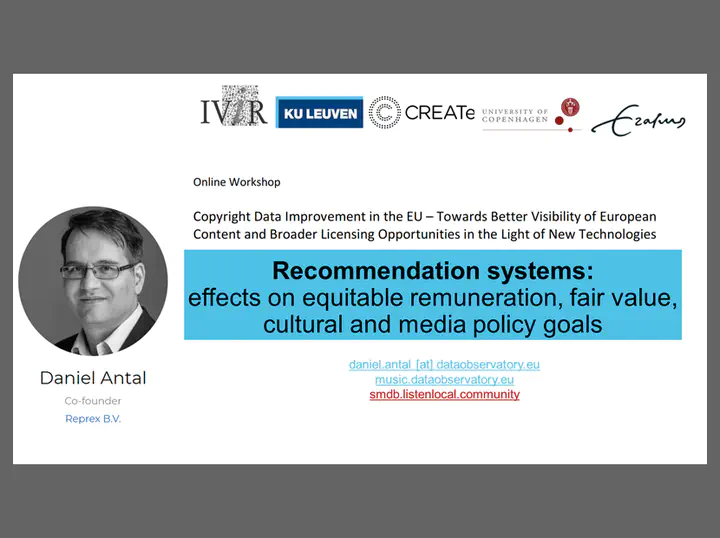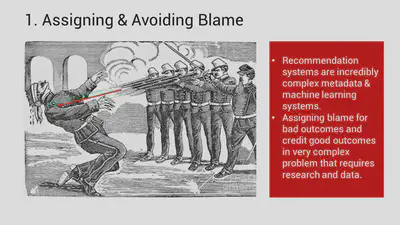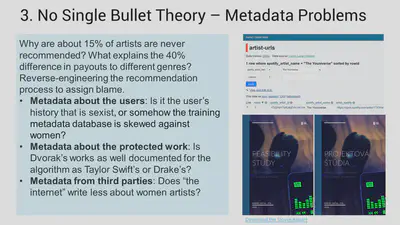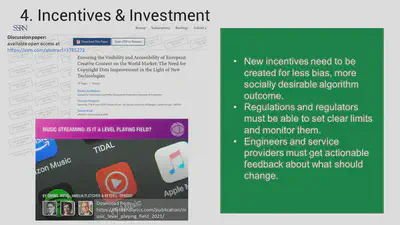Recommendation Systems: What can Go Wrong with the Algorithm?
Effects on equitable remuneration, fair value, cultural and media policy goals
 Copyright Data Improvement in the EU – Towards Better Visibility of European Content
Copyright Data Improvement in the EU – Towards Better Visibility of European Content
Traitors in a war used to be executed by firing squad, and it was a psychologically burdensome task for soldiers to have to shoot former comrades. When a 10-marksman squad fired 8 blank and 2 live ammunition, the traitor would be 100% dead, and the soldiers firing would walk away with a semblance of consolation in the fact they had an 80% chance of not having been the one that killed a former comrade. This is a textbook example of assigning responsibility and blame in systems. AI-driven systems such as the YouTube or Spotify recommendation systems, the shelf organization of Amazon books, or the workings of a stock photo agency come together through complex processes, and when they produce undesirable results, or, on the contrary, they improve life, it is difficult to assign blame or credit.
This is the edited text of my presentation on Copyright Data Improvement in the EU – Towards Better Visibility of European Content and Broader Licensing Opportunities in the Light of New Technologies - download the entire webinar’s agenda.

If you do not see enough women on streaming charts, or if you think that the percentage of European films on your favorite streaming provider—or Slovak music on your music streaming service—is too low, you have to be able to distribute the blame in more precise terms than just saying “it’s the system” that is stacked up against women, small countries, or other groups. We need to be able to point the blame more precisely in order to effect change through economic incentives or legal constraints.
This is precisely the type of work we are doing with the continued support of the Slovak national rightsholder organizations, as well as in our research in the United Kingdom. We try to understand why classical musicians are paid less, or why 15% of Slovak, Estonian, Dutch, and Hungarian artists never appear on anybody’s personalized recommendations. We need to understand how various AI-driven systems operate, and one approach would at the very least model and assign blame for undesirable outcomes in probabilistic terms. The problem is usually not that an algorithm is nasty and malicious; algorithms are often trained through “machine learning” techniques, and often, machines “learn” from biased, faulty, or low-quality information.

In complex systems there are hardly ever singular causes that explain undesired outcomes; in the case of algorithmic bias in music streaming, there is no single bullet that eliminates women from charts or makes Slovak or Estonian language content less valuable than that in English. Some apparent causes may in fact be “blank cartridges,” and the real fire might come from unexpected directions. Systematic, robust approaches are needed in order to understand what it is that may be working against female or non-cisgender artists, long-tail works, or small-country repertoires.
Some examples of “undesirable outcomes” in recommendation engines might include:
- Recommending too small a proportion of female or small country artists; or recommending artists that promote hate and violence.
- Placing Slovak books on lower shelves.
- Making the works of major labels easier to find than those of independent labels.
- Placing a lower number of European works on your favorite video or music streaming platform’s start window than local television or radio regulations would require.
- Filling up your social media newsfeed with fake news about covid-19 spread by some malevolent agents.
These undesirable outcomes are sometimes illegal as they may go against non-discrimination or competition law. (See our ideas on what can go wrong – Music Streaming: Is It a Level Playing Field?) They may undermine national or EU-level cultural policy goals, media regulation, child protection rules, and fundamental rights protection against discrimination without basis. They may make Slovak artists earn significantly less than American artists.

In our work in Slovakia, we reverse engineered some of these undesirable outcomes. Popular video and music streaming recommendation systems have at least three major components based on machine learning:
-
The users’ history – Is it that users’ history is sexist, or perhaps the training metadata database is skewed against women?
-
The works’ characteristics – are Dvorak’s works as well documented for the algorithm as Taylor Swift’s or Drake’s?
-
Independent information from the internet – Does the internet write less about women artists?
In the making of a recommendation or an autonomous playlist, these sources of information can be seen as “metadata” concerning a copyright-protected work (as well as its right-protected recorded fixation.) More often than not, we are not facing a malicious algorithm when we see undesirable system outcomes. The usual problem is that the algorithm is learning from data that is historically biased against women or biased for British and American artists, or that it is only able to find data in English language film and music reviews. Metadata plays an incredibly important role in supporting or undermining general music education, media policy, copyright policy, or competition rules. If a video or music steaming platform’s algorithm is unaware of the music that music educators find suitable for Slovak or Estonian teenagers, then it will not recommend that music to your child.
Furthermore, metadata is very costly. In the case of cultural heritage, European states and the EU itself have been traditionally investing in metadata with each technological innovation. For Dvorak’s or Beethoven’s works, various library descriptions were made in the analogue world, then work and recording identifiers were assigned to CDs and mp3s, and eventually we must describe them again in a way intelligible for contemporary autonomous systems. In the case of classical music and literature, early cinema, or reproductions of artworks, we have public funding schemes for this work. But this seems not to be enough. In the current economy of streaming, the increasingly low income generated by most European works is insufficient to even cover the cost of proper documentation, which then sends that part of the European repertoire into a self-fulfilling oblivion: the algorithm cannot “learn” its properties and it never shows these works to users and audiences.
Until now, in most cases, it was assumed that it is the artists or their representative’s duty to provide high quality metadata, but in the analogue era, or in the era of individual digital copies, we did not anticipate that the sales value will not even cover the documentation cost. We must find technical solutions with interoperability and new economic incentives to create proper metadata for Europe’s cultural products. With that, we can cover one area out of the three possible problem terrains.
But this is not enough. We need to address the question of how new, better algorithms can learn from user history and avoid amplifying pre-existing bias against women or hateful speech. We need to make sure that when algorithms are “scraping” the internet, they do so in an accountable way that does not make small language repertoires vulnerable.

In our paper we argue for new regulatory considerations to create a better, and more accountable playing field for deploying algorithms in a quasi-autonomous system, and we suggest further research to align economic incentives with the creation of higher quality and less biased metadata. The need for further research on how these large systems affect various fundamental rights, consumer or competition rights, or cultural and media policy goals cannot be overstated. The first step is to open and understand these autonomous systems. It is not enough to say that the firing squads of Big Tech are shooting women out from charts, ethnic minority artists from screens, and small language authors from the virtual bookshelves. We must put a lot more effort on researching the sources of the problems that make machine learning algorithms behave in a way that is not compatible with our European values or regulations.